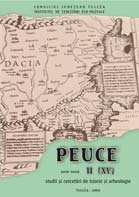Analiza antropologică a osemintelor descoperite în campania din 2002, în necropola romano-bizantină de la Slava Rusă (jud. Tulcea)
Anthropological analysis of human remains discovered during the excavations of 2002, in the Late Roman necropolis from Slava Rusă (Tulcea County)
Author(s): Andrei Dorian Soficaru, Nicolae MiriţoiuSubject(s): Archaeology
Published by: Institutul de Cercetari Eco-Muzeale Tulcea - Institutul de Istorie si Arheologie
Keywords: Dobrogea; (L)Ibida; Slava Rusă; epocă romano-bizantină; necropolă; studiu antropologic Dobrudja; Romano-Byzantine epoch; Roman necropolis; anthropological study
Summary/Abstract: This study represents the second year of collaboration with the Institute of Eco-Museal Research from Tulcea. Here are included the graves dug in July 2002 and the grave 1, discovered in 2001. A number of 32 graves were dug with 36 individuals (the grave 6 was destroyed by treasure seekers). From the 32 graves, 5 had 2 individuals, but we can not sustain if all were double burials. So, M3 contain the human remains of a female (A), 62-70 years old, and the remains of a child (B), 12 years old. We consider about the second case it was a destroyed greave, the remains mixed with the M3 A. Same situation could be observe in the case of M17 A (male, over 60 years old) and M17 B (infans I) or M30 A (female, mature – senilis age) and M30 B (child, 3 years old). Nevertheless M5 (A, mature female and B, new born child) and M29 (A, adult female and B, new born child) are double burials. From 36 individuals, 8 are female and 12 male, and for 16 the sex was undeterminable. Also, from same number, 21 are adult and mature, and 15 children.
Journal: Peuce (Serie Nouă) - Studii şi cercetari de istorie şi arheologie
- Issue Year: II/2004
- Issue No: 2
- Page Range: 329-386
- Page Count: 58
- Language: Romanian

